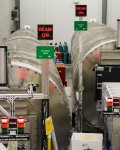The GP-SANS (General Purpose Small-Angle Neutron Scattering) instrument at the High Flux Isotope Reactor has produced a flood of great science since opening to users in 2007. A new detector array just installed at the instrument promises to make users’ time there even more productive by expediting data collection and avoiding downtime.
An array of the same design is scheduled for installation at the Bio-SANS, the second instrument at the HFIR cold neutron source, later this year. The detector upgrade is the first step in a multiple-array detector with additional banks to allow measurement over a broad range of length scales simultaneously with unprecedented speed, says GP-SANS instrument scientist Ken Littrell.
The new system, installed during HFIR’s spring maintenance outage, replaces one that was delivering a lower count rate and limiting the capability of the GP-SANS, says Kevin Berry of the Neutron Sciences Detector Group. It’s a bank of individual 3He-filled linear position-sensitive detectors (LPSDs) with an active area of 1 by 1 meter.
Speed is the new detector’s most attractive feature, says Yacouba Diawara, leader of the Detector Group. Its high count rate allows users to acquire larger data sets faster and opens the way for new applications requiring large dynamic range or time resolution on the scale of a minute or less. Littrell and fellow GP-SANS scientist Yuri Melnichenko note that the new detectors can handle a neutron flux about a hundred-fold larger compared with the original array. “The structures of strongly scattering samples, such as coals, irradiated construction materials in nuclear reactors, and phase-separated metal alloys, can be studied faster and more accurately,” Melnichenko says.
The upgraded system will collect data with improved statistics, especially for strongly scattering materials, that will enable users to more accurately determine the structural parameters of a material sample, resulting in more accurate verification of theoretical (model) predictions.
The instrument scientists foresee that some experiments that were difficult or infeasible before will be facilitated by the upgrade. Kinetics experiments—for example, studies of structural changes induced by abrupt changes in parameters such as temperature, magnetic field, or pressure—will be conducted more quickly and data taken more accurately. SANS users will be able to conduct studies such as time dependence of overall polymer structures in solution, the fast kinetics of fluid adsorption in porous media, and details of the initial stages of phase transitions and decomposition in metallic alloys and polymer blends.
The LPSDs making up the array are made of thin-walled stainless steel tubing, approximately 8 mm in diameter and 1 m long. Each tube is filled with 10 atm 3He gas for neutron conversion, plus quench gas, to give a total pressure of 10.9 atm absolute. The 192 tubes are oriented vertically and arranged into two offset rows of 96 tubes each. The offset is such that each tube in the back row lies exactly between two tubes in the front row, optimizing detection efficiency along the horizontal direction. Each tube has a coaxial electrode geometry and operates in proportional mode.
For ease of assembly, handling, and testing, the design is modular, with eight tubes per module. Each “8 pack” consists of two rows of four offset tubes mounted at each end to an aluminum extrusion to keep the tubes straight. The entire detector array consists of 24 of these 8 packs, mounted side by side onto a common frame.
Any module that goes bad can be easily removed and replaced individually without shutting down the whole array, greatly simplifying maintenance and repair. The original detector was housed in a common enclosure, so detector repair consisted of removing of the entire system and returning it to the factory, leading to long instrument downtimes.
If any part of the original detector failed during a reactor cycle, says Melnichenko, “that would be it: it would have to be delivered to the manufacturer, and ongoing and planned experiments would be cancelled. Imagine this happening to users coming from, say, Europe or Australia.” The new unit is highly unlikely to fail as a whole; and if one or a few tubes stop working, they can be replaced handily, or the detector can operate without them.
Preliminary test results indicate that the GP-SANS detector upgrade is performing as expected, operating at rates at least an order of magnitude greater that the original detector system with little or no indication of saturation effects.
The detector modules were manufactured by GE Reuter-Stokes in Twinsburg, Ohio, modifying a design developed by the Neutron Sciences Detector Group.
An identical array is being assembled and tested for installation into the Bio-SANS during the long shutdown period in fall 2011.
The GP-SANS is the highest-flux SANS instrument in the United States and is comparable to the best SANS instruments in the world. Systems it has studied include polymers, complex biological fluids, metallurgical alloys, advanced nuclear reactor materials, potential media for carbon storage, high-temperature superconductors, and functional nanomaterials.






